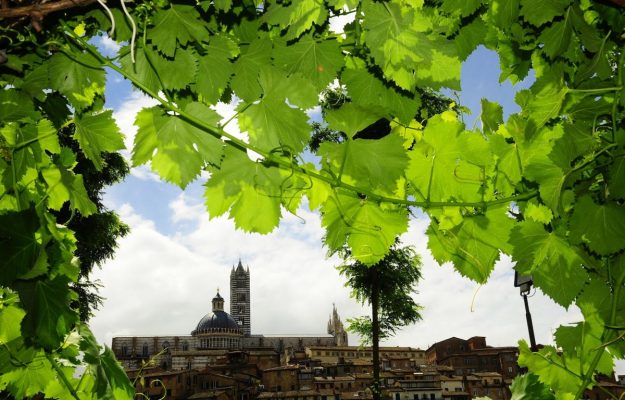Scientists have been repeating this for years: climate change, which affects our entire planet, also puts many crops, such as vines, at risk. In particular, among the grape varieties at the center of attention is Sangiovese, the basis of the most important Made in Italy appellations, especially in Tuscany, from Chianti Classico to Brunello di Montalcino, from Chianti to Vino Nobile di Montepulciano, but also in Romagna, for example. But to rekindle hopes, despite the apocalyptic theories of American climatologist Lee Hannah, there is science, which is already studying possible solutions, such as the “photovoltaic” vineyard and the study of new rootstocks. The topic was developed, in the panel discussion “Climate change, how to save high-risk Italian wine production”, at “Wine & Siena”, an event organized by Merano Wine Festival and Confcommercio Siena.
The talk show featured Helmuth Köcher, The WineHunter and patron of the Merano Wine Festival, with Simone Bastianoni, full professor of Chemistry of the Environment and Cultural Heritage at the University of Siena, as well as coordinator of the Doctoral School in Environmental, Geological and Polar Sciences and Rector’s Delegate for Sustainability. Connecting were Paolo Storchi, Research Director of Crea - Viticulture and Oenology of the Ministry of Agriculture, Food Sovereignty and Forestry and member of the Italian Academy of Vine and Wine; Giulio Somma, editor of “Il Corriere Vinicolo “, the weekly magazine of UIV - Unione Italiana Vini (more than 700 member companies representing more than 50% of Italian sales and 85% of wine exports); and Massimo Aiello, president of Aires, the first network contract for the bioeconomy that brings together Italian utilities and research centers.
A prophetic study that of Lee Hannah of Conservation International’s Betty and Gordon Moore Center for Ecosystem Science and Economics in Arlington, Virginia, argued ten years ago that territories like Bordeaux or Tuscany will become too hot. An average increase of 2 degrees Celsius would lead to the destruction of the current most vocated areas in Italy and France, up to 73% of the total. Giving 2050 as a time horizon. As Professor Simone Bastianoni, full professor of Chemistry of the Environment and Cultural Heritage at the University of Siena, explained, the most current available data are even worse than Hannah’s predictions: “the projections tell us that, by 2050, the average temperature could rise by 2.7-3 degrees Celsius, making it difficult to imagine viticulture in Italy as we see it now”.
“Rising temperatures and lack of rainfall are having serious repercussions on the productivity of the vines and the health and quality of the grapes harvested”, explained Helmuth Köcher, “and some grape varieties, which are more sensitive to climate change, are in danger of being wiped out of their classic production areas”. Among the most susceptible grape varieties is Sangiovese, and as identified by Professor Hannah, and recently confirmed by a study by the National Institute of Research on Agriculture, Food and Environment in Bordeaux (Inrae), among the most exposed highly vocated territories are Burgundy and Tuscany.
But “we will not necessarily have to give up”, said Paolo Storchi, “our historical grape varieties. There are hopes related to the selection of more resilient, drought-adapted clones and rootstocks. Or agricultural practices, such as sustainable irrigation, that can help. Of course, we should not be caught unprepared”. Help could come from innovations produced by the ecological transition. Professor Simone Bastianoni went on to explain how the first experiments on agrivoltaics (a vineyard partially covered by photovoltaic panels) show encouraging data, with a reduction in temperatures, especially at dangerous peak times, of 2 degrees and as much as 3 degrees on the ground, thus canceling out part of the negative effects expected between now and 2050.
“In France, they are already experimenting - added Helmuth Köcher, The WineHunter and patron of the Merano Wine Festival and Wine & Siena (a “four-day” event that has the characteristic of having wine tasted within the frescoed walls of the old Santa Maria della Scala hospital, or the Palazzo Pubblico on the splendid Piazza del Campo, to the most beautiful palaces of the city, one of the absolute capitals of the Middle Ages) and to excite for this special habitat - the photovoltaic vineyard. In Bordeaux, after studies that began in 2009, they have already introduced into their specifications six new grape varieties to replace the current ones, in case the ominous predictions may come true”. Scenarios are opening up to cope with a change that is unquestionably underway, affecting everything and everyone, including the world of wine.
Copyright © 2000/2025
Contatti: info@winenews.it
Seguici anche su Twitter: @WineNewsIt
Seguici anche su Facebook: @winenewsit
Questo articolo è tratto dall'archivio di WineNews - Tutti i diritti riservati - Copyright © 2000/2025









































































































































































































